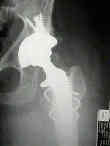- Discussion:
- remove residual cancellous bone along medial aspect of neck w/ broaches;
- begin w/ broach at least two sizes smaller than anticipated stem;
- procede w/ consecutively larger broach sizes up to but not exceeding size of the last axial reamer;
- never use broach > last straight or flexible reamer used;
- remove overhanging trochanteric bone:
- younger patients may have firm overhanging trochanteric bone along with a narrowed tapered medullary canal;
- if the overhanging trochanteric bone is not resected, the femoral stem will be placed in varus or even worse, may result in stem
perforation and/or lateral fracture;
- determination of anteversion:
- from posterior approach, the medial aspect of the broach must be rotated toward the floor;
- probably the least accurate method is to gage anteversion off of the lesser trochanter or the thickness of the calcar;
- most accurate method is to fully internally rotate the hip and to hold the tibia straight upwards;
- the horizontal then indicates zero anteversion, and component is placed in anteversion as it is rotated towards buttocks (using posterior approach);
- determine whether trial femoral broach has enough anteversion (if anteversion is insufficient, then consider a femoral stem w/ built in anteversion);
- do not attempt to place broach in additional anteversion since this leads to undersizing of stem w/ insufficient rotational stability;
- for optimal sizing of the femoral stem, align broach to precisely match axis of patient's femoral neck;
- references:
- Computed tomographic evaluation of component position on dislocation after total hip arthroplasty.
- The effect of anteversion on femoral component stability assessed by radiostereometric analysis
- The Combined Anteversion Technique for Acetabular Component Anteversion
- Increased Anteversion of Press-fit Femoral Stems Compared With Anatomic Femur
- assess broach within canal:
- broach should be in intimate contact w/ large portion of endosteal cortex, exp medially and posteriorly;
- occassionally, straight stems will not have tight fit anteriorly;
- cutting teeth of broach may impinge on hard cortical bone along the posterior aspect of femoral neck;
- this is esp true if femoral neck cut has been cut obliquely with posterior femoral cortex being higher than anterior cortex;
- if this occurs then carefully remove area of impingement w/ burr;
- aggressive broaching places the broach in direct contact with cortical bone and generates high hoop stresses in the proximal femur;
- since proximal femur is so poorly equipped to resist hoop stresses frx is common when standard broaching techniques are used;
- seating of the final broach is performed carefully - after advancing the broach several mm consider backing it out to avoid entrapment and frx;
- avoid varus positiong:
- if the final broach stem is undersized compared to the preoperative template, then the stem may be in varus;
- varus positioning is avoided by keeping the lateral edge of the broach up against the greater trochanter and by aiming the broach at
the medial femoral condyle;
- trial reduction considerations: final broach is used a femoral trial;
- determine whether there is enough horizontal offset (from preoperative templates);
- options include choosing a stem with increased femoral horizontal offset;
- w/ excessive soft tissue tension (absence of any shuck with traction), consider recutting the femoral neck to (decrease vertical offset) and
then subsequently increase femoral neck length;
- because femoral components usually have a 35 deg neck angle to horizontal, a longer neck length will increase horizontal offset > verticle ht;
- avoid over sizing the broach:
- ensure that broach is not "overstuffed" at its final level, realizing that definative stem may have a coating which
will add an additional 1/2 mm, which risks having the final broach sit proud or risks fracture as it reaches
the femoral neck level;
- if the optimal final broach size remains in question, use the smaller broach size for the trial reduction;
- if the hip ends up being stable without having to use an increased modular neck size, then the femoral neck is cut more distally, and
smaller stem can be driven more distally
- which will allows an optimal fit within the canal without increasing leg length;
- if an oversized broach (or stem) is left proud, then verticle offset is excessively increased which leads to leg length inequality;
- intraoperative femur frx;
- if an oversized stem is excessively impacted, then there is the risk of fracture;
- be aware of potential for frx in osteoporotic patients as occured in this patient w/ cerebral palsy who was non wt bearing on the operative side
- Insertion of the Cementless Component:
The effect of anteversion on femoral component stability assessed by radiostereometric analysis.
Factors predisposing to dislocation after primary total hip arthroplasty. A multivariate analysis.



